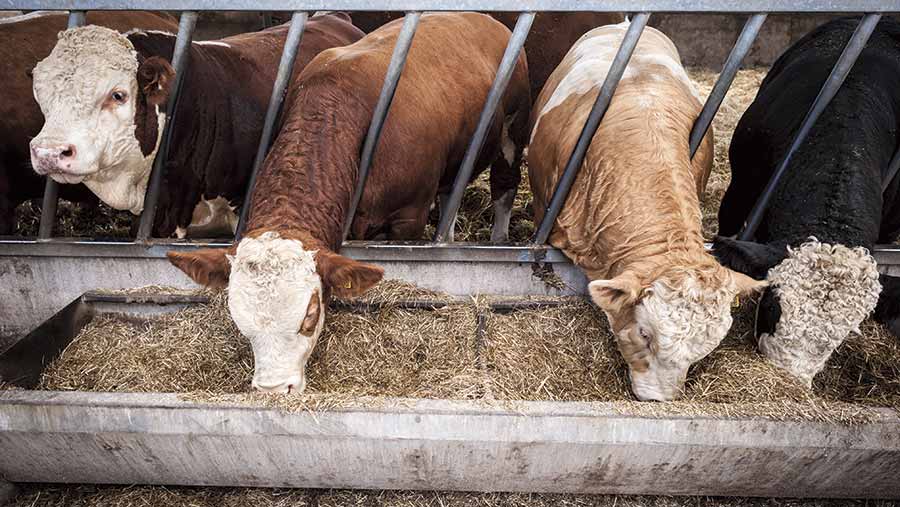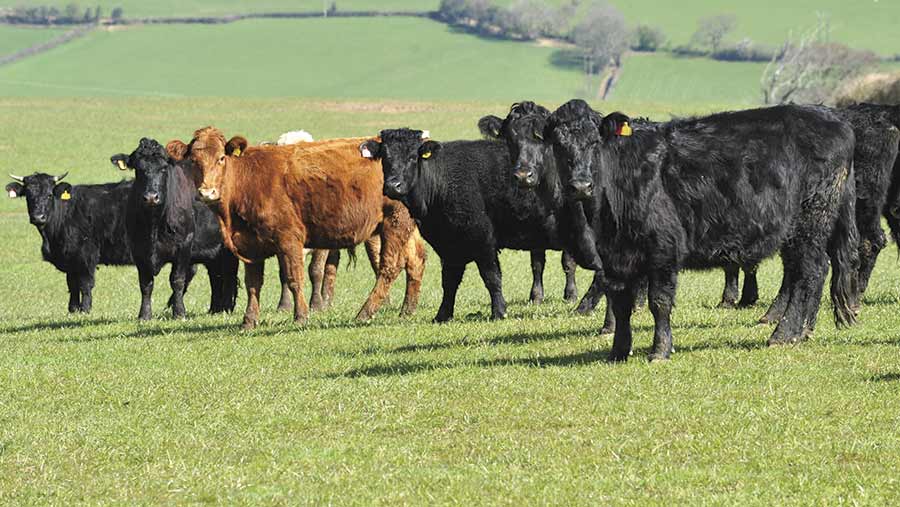Three-stage approach helps meet beef specifications
Formulating rations specific to each of the three stages of production is one of the best ways the industry can achieve new market requirements, according to independent ruminant nutritionist David Hendy.
Currently, only 60% of cattle are meeting target carcass confirmation and fat class specification. While this is gradually improving and carcass requirements are changing, Mr Hendy predicts that requirements for carcass weights will only tighten further.
“I think that within 18 to 24 months we will see requirements for 380kg carcasses but, rather than fear this, beef farmers should regard it as a much more efficient way to produce a carcass.

© Jim Varney
“It is no different to what farmers were doing in the 1970s. Yes, breeds and systems have changed since then but there is no reason that by utilising early growth this can’t be achieved, even with continental cattle.”
See also: Tips on meeting new lighter-weight beef specifications
Mr Hendy believes the rearing and growing periods have become more important than ever to avoid animals growing too big at the finishing stage.
The underlying principle is to maximise the inclusion of farm-grown feeds, balanced with high-quality purchased feeds if needed.
Below, Mr Hendy summarises what to feed at each stage to maximise gains.
Stage one: Rearing – birth to nine months
The full potential of feed conversion efficiency of calves from birth to eight to nine months of age must be exploited, regardless of breed, sex, production system or target market.
Introduce creep feed to suckler calves at four to five months to prepare the calf for weaning and to maximise liveweight gain.
Aims and creep recommendations:
- The calf should double its birthweight by 60-65 days and triple birthweight by 105 days
- Relatively high crude protein of 16-18kg of dry matter (DM) with at least 25-30% bypass protein
- Energy levels should be moderate, at 11.4-12 ME/kg DM with target gains of 1-1.4kg/day
- A high level of digestible fibre at this stage – approximately 30% NDF.
Stage two: Growing – eight to nine months to finishing
The growing period – from weaning to finishing – should focus on controlled and continuous frame growth before the animal moves to a short, sharp period of maximum weight gain at finishing. Avoiding a stop/start growth pattern is key at this stage.
“Eliminate any need for compensatory gain; compensatory gain is fine if you’re buying store cattle and you benefit from their compensatory growth, but now that age and carcass weight are becoming more important, then continuous, steady and controlled growth rates are much more important.”
When growing cattle are housed during late autumn and winter the best use of farm-grown feeds should be made. This should be predominately forage-based with a moderate energy density ranging from 10.6-11.6ME/kg DM.
Aims and feed recommendations:
- Feed a ration to produce 0.8-1.1kg/head/day
- To avoid early fat deposition, starch and sugars should be held at moderate levels – no greater than 20%
- To encourage frame growth, the ration should have a reasonably high crude protein of between 13.5-14.5%/kg DM, with at least 15% bypass protein and high digestible and structural fibre.
Stage three: Finishing
Achieving optimum liveweight gain is essential at this stage as the ration will have a high-energy density cost and the animal’s FCE will greatly diminish.
Aims and feed recommendations:
- The finishing period should be no longer than 80 to 120 days
- Target gains during this period should be as high as possible – between 1.3 -1.8kg/head/day, depending on the animal
- The ideal ration for steers and continental heifers can be achieved with rations with a high metabolised energy and high starch – at least 12.0ME/kg DM, over 30% starch and protein levels of 12-14%
- The diet at this stage should be higher in rumen degradable protein to feed the rumen micro-organisms
- But lower in bypass protein
- It should have a digestible fibre of 25% NDF and include high-quality forages
- Add up to 10% of long fibre/kg of dry matter to promote rumen function.
Example rearing ration
|
Ration |
Diet specification |
|
2% chopped straw 20% Whole oats 10% rolled wheat 7% Rapeseed meal 0.65% minerals/vitamins 0.65% limestone flour 30% Maize silage 30% Grass silage
Approximate cost: £0.90/day £0.90/kg gain @ 1kg/day £154.00/t dry matter £68.40/t fresh weight |
Dry matter 44.6% ME (MJ/kg DM) 11.5 Crude protein 14.7% ERDP: FME 10.7 : 1 NDF 32.4% Sugar 3% Starch 32% Oil/fat 4.8% Ca 1.1% P 0.48 % Mg 0.19%
|
Example growing ration
|
Ration |
Diet specification |
|
2.5% chopped straw 23% chopped fodder beet 6% rolled barley 6% rapeseed meal 0.35% minerals/vitamins 0.35% limestone flour 20% maize silage 41.8% grass silage
Approximate cost: £0.92/day £0.92/kg gain @ 1.0kg/day £117.70/t dry matter £42.4/t fresh weight |
Dry matter 36% M/D (MJ/kg DM) 10.5 to 11.3 Crude protein 14.0% ERDP:FME 11:1 NDF 40% Sugar 10.7% Starch 13.7% Oil/fat 3.1% Ca 0.6% P 0.3.4% Mg 0.15%
|
Example finishing ration for indigenous/native British cattle
|
Ration |
Diet specification |
|
2% chopped straw 31% chopped fodder beet 6.5% rolled barley 4.5% rapeseed meal 0.3% minerals/vitamins 0.3% limestone flour 19% maize silage 37% grass silage
Approximate cost: £1.21kg/day fresh weight £0.97/kg gain @ 1.25kg/day £114.5/t dry matter £38.7/t fresh weight |
Dry matter 33.8% M/D (MJ/kg DM) 11.2 Crude protein 13% ERDP: FME 9.8:1 N.D.F 38% Sugar 14.6% Starch 14.6% Oil/fat 2.8% Ca 0.96% P 0.4% Mg 0.18%
|
Example finishing ration for continental cross cattle
|
Ration |
Diet specification |
|
2% chopped straw 35% chopped fodder beet 25% rolled wheat 4% Rapeseed meal 0.35% minerals/vitamins 0.35% limestone flour 33.3% Maize silage
Approximate cost: £1.49/day £1.00/kg gain @ 1.5kg/day £138.4/t dry matter £59.60/t fresh weight |
Dry matter 43.56% ME (MJ/kg DM) 12.1 Crude protein 12.8% ERDP: FME 8.6:1 NDF 23.5% Sugar 12% Starch 40% Oil/fat 2% Ca 0.93% P 0.47% Mg 0.18%
|
Case study: Barton Abbey Farms, Oxfordshire
A twofold strategy of fine tuning rations and earlier drafting of cattle for slaughter is enabling an Oxon beef producer to achieve finishing weights of 400kg deadweight at under 24 months.
Barton Abbey Farms at Chipping Norton produces beef from a spring calving herd of 110 Charolais-cross and Saler-cross suckler cows.
They use Charolais, Saler and Aberdeen Angus bulls to produce finished cattle for Dawn Meats to supply M&S and McDonald’s.
Cattle were being finished at over 24 months, but last year the majority were slaughtered at between 21-22 months and achieved R and U grades.
See also: Farmers Weekly Awards 2016: Beef Farmer of the Year
Getting to this point has been a challenge admits farm manager Richard Long, with the Charolais proving to be the more difficult to finish at the new carcass weight specifications.
“As Charolais are late maturing it’s critical to get early growth rates through the rearing and growing periods so that finishing can be a shorter but more determined period to achieve the lighter carcass weights now required,” he says.
“We’re now achieving this at well under 24 months but still making sure the animal reaches its genetic potential for grade and fat cover.”
Ration
The total mixed finishing ration consists of home-grown silage and winter rolled barley, with the barley fed to a daily maximum of 8kg a head.
Up to 50g a head a day of Feed Grade Urea is also included to increase the level of rumen degradable protein in the ration. The quantity fed depends on the crude protein level in the grass silage and rolled barley.
Mr Long says attention is always given to making high-quality grass silage as this will form between 50% and 60% of dry matter intake in the grower ration and 40% to 50% of dry matter intake in the finisher diet.
“Other protein sources, such as beans, rapeseed meal and wheat distillers pellet, have and will be used dependent on the unit cost of protein,” says Mr Long.
The cattle to be finished start to be housed from the end of September and the first animals are drafted for slaughter in December. “Previously we were having one pick in December but we now do this twice. As soon as cattle are housed we push them hard and select them sooner than we used to.”

